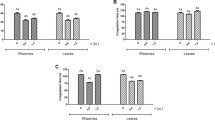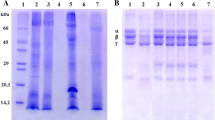Abstract
In the present work, ethyl acetate extracts, consisting of non-volatile compounds, from the culture of endophytic fungi isolated from coffee plants, Induratia coffeana and Induratia yucatanensis, were prospected in enzyme modulation tests that act in human hemostasis. Dry extracts of the fungi were diluted in dimethyl sulfoxide p.a. 99.9% (DMSO), and then tested. Bothrops atrox venom was used as an enzyme source and tool to induce the activities. Prior to the evaluation of the activities, incubations of the extracts with the venom were performed in the proportions 1: 0.01, 1: 0.25, 1: 0.5, and 1: 1 (venom: extract; mass: mass). The extracts of all fungi promoted a significant increase in the clotting time induced by the venom, which was even longer when the extracts were previously incubated with the citrated plasma. The activity of phospholipases A2 did not significantly change when evaluated in the presence of fungal extracts. However, the evaluated extracts inhibited proteases by 73% and 30% in the thrombolytic and caseinolytic tests, respectively. In addition, the extracts did not induce cytotoxicity on human erythrocytes when evaluated in the absence of the venom. Thus, it is possible to suggest the presence of specific interactions between molecules present in extracts of Induratia spp. and venom proteases, highlighting non-volatile metabolites as promising sources of compounds of medical and scientific interest.

Similar content being viewed by others
References
Nisa H, Kamili AN, Nawchoo IA, Shafi S, Shameem N, Bandh SA (2015) Fungal endophytes as prolific source of phytochemicals and other bioactive natural products: a review. Microb Pathog 82:50–59
Ali L, Khan AL, Hussain J, Al-Harrasi A, Waqas M, Kang SM, Al-Rawahi A, Lee IJ, Ali L (2016) Sorokiniol: a new enzymes inhibitory metabolite from fungal endophyte Bipolaris sorokiniana LK12. BMC Microbiol 16:103
Patil RH, Patil MP, Maheshwari VL (2016) Bioactive secondary metabolites from endophytic fungi: a review of biotechnological production and their potential applications. In: Rahman AU (ed) Studies in natural products chemistry. Elsevier, Netherlands, pp 189–205
Yan L, Zhao H, Zhao X et al (2018) Production of bioproducts by endophytic fungi: chemical ecology, biotechnological applications, bottlenecks, and solutions. Appl Microbiol Biotechnol 102:6279–6298
Tanapichatsakul C, Khruengsai S, Pripdeevech P (2019) Production of eugenol from fungal endophytes Neopestalotiopsis. sp and Diaporthe. sp isolated from Cinnamomum loureiroi leaves. PeerJ 7:e6427
Ancheeva E, Daletos G, Proksch P (2020) Bioactive secondary metabolites from endophytic fungi. Curr Med Chem 27:1836–1854
Suwannarach N, Kumla J, Sujarit K, Pattananandecha T, Saenjum C, Lumyong S (2020) Natural bioactive compounds from fungi as potential candidates for protease inhibitors and immunomodulators to apply for Coronaviruses. Molecules 25:1800
Kaaniche F, Hamed A, Abdel-Razek AS et al (2019) Bioactive secondary metabolites from new endophytic fungus Curvularia sp. isolated from Rauwolfia macrophylla. PLoS ONE 14:e0217627
Helaly SE, Thongbai B, Stadler M (2018) Diversity of biologically active secondary metabolites from endophytic and saprotrophic fungi of the ascomycete order Xylariales. Nat Product Rep 35:992–1014
Hyde KD, Xu J, Rapior S et al (2019) The amazing potential of fungi: 50 ways we can exploit fungi industrially. Fungal Divers 97:1–136
Kuźniar A, Włodarczyk K, Wolińska A (2019) Agricultural and other biotechnological applications resulting from trophic plant-endophyte interactions. Agronomy 9:779
Samarakoon MC, Thongbai B, Hyde KD, Brönstrup M, Beutling U, Lambert C, Miller AN, Liu J-KJ, Promputtha I, Stadler M (2020) Elucidation of the cycle of the endophytic genus Muscodor and its transfer to Induratia in Induratiaceae fam. nov., based on a polyphasic taxonomic approach. Fungal Divers 101:177–210
Strobel GA, Dirkse E, Sears J, Markworth C (2001) Volatile antimicrobials from Muscodor albus, a novel endophytic fungus. Microbiology 147:2943–2950
Strobel G (2011) Muscodor species—endophytes with biological promise. Phytochemistry 10:65–172
Monteiro MCP, Alves NM, Queiroz MV, Pinho DB, Pereira OL, Souza SMC, Cardoso PG (2017) Antimicrobial activity of endophytic fungi from coffee plants. Biosci J 33:381–389
Gupta M, Meshram V (2018) The biological promises of endophytic Muscodor species. In: Gehlot P, Singh J (eds) Fungi and their role in sustainable development: current perspectives. Springer, Singapore, pp 51–74
Alves NM, Guimarães LHS, Piccoli RH, Cardoso PG (2016) Production and partial characterization of an extracellular phytase produced by Muscodor sp. under submerged fermentation. Adv Microbiol 6:23–32
Monteiro MCP, Tavares DG, Nery EM, Queiroz MV, Pereira OL, Cardoso PG (2020) Enzyme production by Induratia spp. isolated from coffee plants in Brazil. Braz Arch Biol Technol 63: e20180673. https://doi.org/10.1590/1678-4324-2020180673
Kapoor N, Saxena S (2016) Xanthine oxidase inhibitory and antioxidant potential of Indian Muscodor species. 3 Biotech 6:248
Macías-Rubalcava ML, Hernández-Bautista BE, Oropeza F, Duarte G, González MC, Glenn AE, Hanlin RT, Anaya AL (2010) Allelochemical effects of volatile compounds and organic extracts from Muscodor yucatanensis, a tropical endophytic fungus from Bursera simaruba. J Chem Ecol 10:1122–1131
Qadri M, Nalli Y, Jain SK, Chaubey A, Ali A, Strobel GA, Vishwakarma RA, Riyaz-Ul-Hassan S (2017) An insight into the secondary metabolism of Muscodor yucatanensis: Small-molecule epigenetic modifiers induce expression of secondary metabolism-related genes and production of new metabolites in the endophyte. Microb Ecol 73:954–965
Suwannarach N, Kumla J, Matsui K, Lumyong S (2015) Characterization and efficacy of Muscodor cinnamomi in promoting plant growth and controlling Rhizoctonia root rot in tomatoes. Biol Control 90:25–33
Franco RF (2001) Fisiologia da coagulação, anticoagulação e fibrinólise. Medicina (Ribeirão Preto. Online) 34:229–237
Choi BS, Sapkota K, Choi JH, Shin C, Kim S, Kim SJ (2013) Herinase: a novel bi-functional fibrinolytic protease from the monkey head mushroom, Hericium erinaceum. Appl Biochem Biotechnol 170:609–622
Dennis EA, Cao J, Hsu YH, Magrioti V, Kokotos G (2011) Phospholipase A2 enzymes: physical structure, biological function, disease implication, chemical inhibition, and therapeutic intervention. Chem Rev 111:6130–6185
Marcussi S, Santos PRS, Menaldo DL, Silveira LB, Santos-Filho NA, Mazzi MV, Da Silva SL, Stábeli RG, Antunes LMG, Soares AM (2011) Evaluation of the genotoxicity of Crotalus durissus terrificus snake venom and its isolated toxins on human lymphocytes. Mut Res Genet Toxicol Environ Mutagenes 724:59–63
Marques TR, Braga MA, Cesar PHS, Marcussi S, Corrêa AD (2019) Jabuticaba (Plinia jaboticaba) skin extracts as inhibitors of phospholipases A2 and proteases. Anais da Acad Bras de Ciências 91:16
Cardoso MGB, Trento MVC, Reis CH, Marcussi S, Cardoso PG (2019) Lecanicillium aphanocladii: snake venom phospholipases A2 and proteases as tools to prospect enzymatic inhibitors. Lett Appl Microbiol 69:88–95
Cesar PHS, Trento MVC, Sales TA, Marques TR, Braga MA, Ramalho TC, Marcussi S (2019) Molecular interactions between p-coumaric acid and snake venom toxins. J Cell Biochem 120:14594–14603
Gutiérrez JM, Chaves F, Gené JA, Lomonte B, Camacho Z, Schosinsky K (1989) Myonecrosis induced in mice by a basic myotoxin isolated from the venom of the snake Bothrops nummifer (jumping viper) from Costa Rica. Toxicon 27:735–745
Cintra ACO, De Toni LGB, Sartim MA, Franco JJ, Caetano RC, Murakami MT, Sampaio SV (2012) Batroxase, a new metalloproteinase from Bothrops atrox snake venom with strong fibrinolytic activity. Toxicon 60:70–82
Wang WJ, Shih CH, Huang TF (2004) A novel P-I class metalloproteinase with broad substrate-cleaving activity, agkislysin, from Agkistrodon acutus venom. Biochem Biophys Res Commun 324:224–230
Dunaevsky YE, Popova VV, Semenova TA, Beliakova GA, Belozersky MA (2014) Fungal inhibitors of proteolytic enzymes: classification, properties, possible biological roles, and perspectives for practical use. Biochimie 101:10–20
Saavedra SL, Avila L, Giudicessi SL, Albericio F, Camperi SA, Cascone O, Martinez-Ceron MC (2018) Natural snake venom inhibitors and their pharmaceutical uses: challenges and possibilities. Curr Pharm Des 24:1737–1747
Mehta AY, Jin Y, Desai UR (2014) An update on recent patents on thrombin inhibitors (2010–2013). Expert Opin Ther Pat 24:47–67
Sixma JJ, De Groot PG (1992) The ideal anti-thrombotic drug. Thromb Res 67:305–311
Costa JO, Fonseca KC, Mamede CCN, Beletti ME, Santos-filho NA, Soares AM, Arantes EC, Hirayama SNS, Selistre-Dearaújo HS, Fonseca F, Henrique-Silva F, Penha-Silva N, Oliveira F (2010) Bhalternin: functional and structural characterization of a new thrombin-like enzyme from Bothrops alternatus snake venom. Toxicon 55:1365–1377
Gutiérrez JM, Rucavado A, Escalante T, Lomonte B, Ângulo Y (2010) Tissue pathology induced by snake venoms: how to understand a complex pattern of alterations from a systems biology perpective? Toxicon 55:166–170
Kini RM, Kho CY (2016) Metalloproteases affecting blood coagulation, fibrinolysis and platelet aggregation from snake venoms: Definition and nomenclature of interaction sites. Toxins 8:284
Acknowledgements
This research was supported by Coordenação de Aperfeiçoamento de Nível Superior (CAPES), Fundação de Amparo à Pesquisa do Estado de Minas Gerais (FAPEMIG), Conselho Nacional de Desenvolvimento Científico e Tecnológico (CNPq) and Universidade Federal de Lavras (UFLA).
Author information
Authors and Affiliations
Contributions
Conceptualization: APDSPB, PGC, LCJP, SM. Data acquisition: Bastos APDSPB, MVCT. Data analysis: APDSPB, ÍAFMS, SM. Design of methodology: APDSPB, PGC, MVCT, LCJP, SM. Writing and editing: APDSPB, PGC, ÍAFMS, MVCT, LCJP, SM.
Corresponding author
Ethics declarations
Conflict of interest
We declare that we have no conflict of interest in this work.
Additional information
Publisher's Note
Springer Nature remains neutral with regard to jurisdictional claims in published maps and institutional affiliations.
Rights and permissions
About this article
Cite this article
Bastos, A.P.d.P., Cardoso, P.G., Santos, Í.A.F.M. et al. Enzymatic Modulators from Induratia spp.. Curr Microbiol 77, 3603–3611 (2020). https://doi.org/10.1007/s00284-020-02170-5
Received:
Accepted:
Published:
Issue Date:
DOI: https://doi.org/10.1007/s00284-020-02170-5




